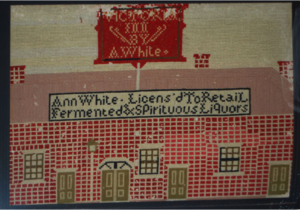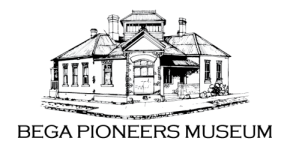Ann White Tapestry
 Made by Anne White, original licensee of the Victoria Inn, Bega, from 1855 to 1880
Made by Anne White, original licensee of the Victoria Inn, Bega, from 1855 to 1880
Long-time Bega business woman Anne White had a lengthy association with inn keeping in the township.
She and her husband Isaac operated what was referred to as a “shanty” beside the huts on the Brogo River bank at Yarranung in the early 1850s. According to the Government Gazette of 1851, this was “…the first public house between Moruya and Pambula..”
By 1853, they had moved and licensed the Victoria Inn, described as rented premises in Bega. A commodious building, the inn consisted of three parlours, ten bedrooms, kitchen, stables and coach-house. In 1854, Isaac’s license was renewed by the Eden Licensing Court, but in March 1855, he was killed in an unusual manner. According to an April 1855 report of the incident, “While standing in the Bar of his Inn, with two of his children in his company and another child which he was supporting…lightning came through the jamb of the door and knocked the head out of a cask of spirits, without breaking any other particle of the cask and knocked down the whole of the four persons, and killed Mr. White on the spot…”
Like so many other inn keepers throughout the Colony at the time, Isaac had arrived in New South Wales in 1832 as a convict, one of 224 on board the Isabella. Sentenced to life at the Somerset Assizes, he departed England in November 1831, leaving behind his wife Ann and their two children.
Born in Widcombe, Wiltshire, England in August 1807 to Ann and William Stevenson and baptised at Calne Parish Church the following month, Ann married Isaac White at St. James Parish Church, Bath, England in February 1829. Their two youngest children were born in England, William Isaac in about 1829 and Jane Rebecca in 1832.
After Isaac’s conviction and transportation to the penal colony of New South Wales, Ann together with her son and daughter followed in 1846 on board the ‘Eweretta’.
On the recommendation of the Berrima Bench, Isaac was granted Tickets of Leave in 1842, 1846 and 1847, before securing his Conditional Pardon in 1848. After Ann’s arrival in the colony, the couple had two more children, Mary Ann, born in September 1847, and John James, born in 1849, both at Greenland, a station near Nimmitabel on the Monaro, New South Wales.
In the wake of her husband’s sudden and tragic death, the license for the Victoria Inn was transferred to Annie the following month. A renewal was granted in 1856, but when she came before the Bench in 1857, Ann, along with other local innkeeper Samuel Mead of Bega’s Traveller’s Rest, were both refused “…on the grounds of their having supplied Aboriginal natives with rum.” Sparking outrage amongst local residents, the local correspondent to the Illawarra Mercury commented that “It remains to be seen whether the two houses will be shut up in our locality. One thing is certain, if we have no licensed houses in our neighbourhood (which are indispensable and of easy access to the police), it is to be feared we shall have a much worse infliction in the shape of sly-grog shops for, unfortunately, human nature is on much the same footing here as elsewhere in the colony.” In May, when the licensing issue again came before the Eden Bench, the majority of the magistrates again opted for refusal, this time based on “…the absence of police protection.” Soon after, Legislative Council member Mr. Egan took up the case, making a motion in parliament that the Governor-General be presented with an address regarding the reasoning behind the refusal to relicence the hotels in question, making particular note that Mrs. White’s “…sole means of supporting herself had been taken from her by her licence being refused…“ In response to the situation, two constables from the Eden Police were detached to Bega in late 1857 and on January 7, 1858, the Government Gazette proclaimed Bega as a “…place where a Court of Petty Sessions might be holden.” As a result, the Eden Bench reinstated Ann White’s license for the Victoria Inn in September 1857.
By 1858, Ann White had moved to construct her own purpose built premises for the Victoria Inn, and in August that year, the Illawarra Mercury reported that “Mrs. A. White’s new public house, which is being built of brick, is progressing fast…” A week later, the same newspaper noted that “Mrs. A. White intends making application for the transfer of her license from her present residence to the new house now in the course of erect [sic] in Auckland Street, Bega, at the court which is to be holden for that purpose…on the 7th proximo at Eden.”
The first brick building to be constructed in the Bega township, the premises “…on the line of road from Eden to the Clyde at present doing a good paying business…” was advertised for sale in 1860. It was described as “…very substantially built of brick and contains three parlours, five bedrooms and servants’ rooms, tap-room and spacious bar, store room and pantry, with detached kitchen.” The property also boasted a six-stall stable, wash-houses, stockyard, cow bails, calf pens, styes and “…every convenience required…”
Annie also opened a billiard’s room opposite the Victoria Inn in 1865.
Ann White made liberal use of temporary licensing permits for off site functions: for example, in 1873 she kept a booth at the Catholic Bazaar; and in 1874 at a local exhibition event.
With Bega then boasting few public buildings, the Victoria Inn effectively become the town’s civic centre. Meetings, gatherings, church services and other community events were all held there. In July 1857, it was the venue for the meeting that led to establishment of the Bega Agricultural Society. I in December the same year, a public meeting was held there to organise a two-day racing event. In 1858, it hosted Mr. Grealy’s public auction of Mr. Maxwell’s store stock. When Bega’s original court house became to small, cases were heard at the Victoria Inn. One room was utilised by the Commercial Bank while their
In January 1864, the Victoria Inn hosted a dinner for local and visiting cricket clubs in her “new Assembly Room“. In August the same year it provided the venue for a farewell town function to mark Mr. S. Kirkwood’s impending departure from Bega. The Sydney Morning Herald reported of the event that “The table was laid in Mrs. White’s large room, Victoria Inn, the spread being all that could be desired, the wines excellent, and the whole affair in the highest degree creditable to the worthy hostess…” In May 1867, she also hosted the Annual Race Ball in her “…large and commodious room in Auckland Street…. “ Mrs. White’s Victoria Inn was mentioned in the 1866 Bailliere’s Gazetteer, while local print media carried advertisements in 1867 and 1868. An 1871 Town and Country Journal article also made mention of “…Mrs. White’s Victoria Inn…” and in 1872 Ann White was listed in the Greville’s Post Office Directory as an innkeeper in Auckland Street, Bega.
She remained licensee of the Victoria Inn until 1880, when another local business woman, Mrs. Agnes McPhee, formerly of Pambula’s Roan Horse Inn, took over. Annie White’s Victoria Inn continues to stand today (2014), next to the Bega Pioneer’s Museum, and is believed to the earliest extant building in the Bega township.
Noted for her benevolent and charitable qualities, it was said that Annie White never turned any poor wayfarer away. Her kindness to scores of sufferers was proverbial, so much so that the “…good lady’s legitimate income was often overdrawn in consequence of years of open-handed hospitality to the poor and needy.”
Annie White passed away in August 1888.
